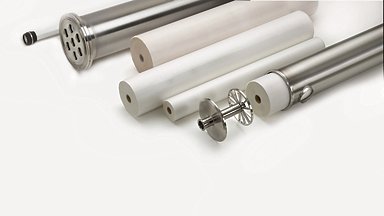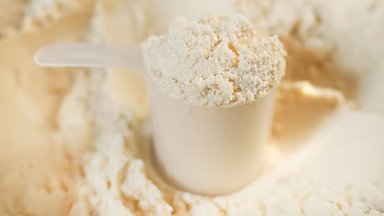Fast growth in a popular market
Products derived from milk and whey are of four main types:
- Protein-based ingredients – used in infant formula, food and sport and senior nutrition products
- Mineral-based ingredients – used as nutritional supplements
- Lactose-based ingredients – used in snack, confectionary and nutritional products
- Hydrolysates – used in infant formula and dietary products
Across these products, we at Tetra Pak provide innovative membrane filtration solutions that help you create the high-quality and high-value products the market demands.
Uses

Whey protein concentrate and isolate
High dry-matter content
Whey protein concentrates (WPC) are high-value products that are widely used in food processing and are produced using membrane filtration. WPC powder is created by drying the retentates from ultrafiltration of whey. Its protein content ranges from 35 percent to more than 80 percent protein in solids. WPC 80 or above is produced by ultrafiltration of liquid whey including diafiltration in order to wash out enough lactose. Whey protein isolate (WPI) containing more than 92 percent protein in solids, measured as dry matter, is a popular ingredient in protein supplements.

Milk protein concentrate and isolate
Functional properties
Milk protein concentrate (MPC) and milk protein isolate (MPI) are concentrated forms of milk protein that are commonly in sports nutritional, functional food and infant nutritional products. They contribute functional properties to food products, such as emulsification, water binding and texture enhancement. MPC is made by treating milk with ultrafiltration. The membranes allow water, lactose and minerals to pass through while retaining proteins. Further concentration removes additional water to create a concentrated milk protein product. MPI typically has a higher protein concentration than MPC and is also produced using microfiltration to isolate specific protein fractions and remove impurities.

Micellar casein concentrate and isolate
Food and supplement ingredients
Micellar casein concentrate (MCC) and micellar casein isolate (MCI) are protein products derived from milk. They are made specifically from casein, the main protein in milk. They are widely used in the food and supplement industry. The production of MCC involves separating casein from whey by microfiltration. The process helps retain the micellar structure of casein – a natural arrangement of spherical clusters called micelles. MCI has a higher and more concentrated casein protein content than MCC and requires more filtration and purification steps to isolate and concentrate the micellar casein fraction while minimizing other protein presence.

Mineral and lactose products
Diversification opportunity
Mineral-based ingredients such as calcium phosphate are commonly used as nutritional supplements, while lactose-based ingredients such as lactose and permeate powder have wide applications in snack, confectionary and nutritional products. Protein and lactose hydrolysates are popular ingredients in infant formula and dietary products. All derived from milk and whey and produced using microfiltration or ultrafiltration, these products represent an opportunity for dairy and food producers interested in expanding their portfolios and market reach.

PROTEIN AND CASEIN CONCENTRATION AND FRACTIONATION
Powder processing
Milk-based, tailormade products are a fast-growing product segment. Membrane technology is integral to ingredient processing in this category, which includes infant formula as well as senior and sports nutrition products and other foods. Input products and ingredients in this field include milk protein concentrate (MPC), milk protein isolate (MPI), micellar casein concentrate (MCC) and micellar casein isolate (MCI).
Technologies

Fat and protein separation
Ultrafiltration
Ultrafiltration is used for concentrating large molecules such as fat and protein in raw or pasteurised whole or skim milk and for reducing lactose and mineral content. Typical products include milk protein concentrate (MPC) and milk protein isolate (MPI). Diafiltration is often used here to increase the protein-to-dry-matter ratio to achieve high-grade varieties such as MPC 85. Ultrafiltration is also used to concentrate whole or standardised milk for the production of fully or partially concentrated cheeses.

Ion and mineral removal
Nanofiltration
The diluted streams from microfiltration and ultrafiltration processes are often concentrated using nanofiltration or reverse osmosis – or a combination of the two. The nanofiltration process removes or recovers water and also separates monovalent ions, thus demineralizing the product. Nanofiltration plays a role in the production of products such as milk protein concentrate (MPC), milk protein isolate (MPI) and infant formula. The technology uses slightly more open membrane pores than reverse osmosis. These allow small ions such as dissolved minerals to pass but exclude larger ions and most organic components such as bacteria, spores, fats, proteins, gums and sugars.

Valuable concentration step
Reverse osmosis
Reverse osmosis is a highly useful and cost-effective way to pre-concentrate milk and whey before drying. It is a powerful driver of energy efficiency in milk and whey powder production.











